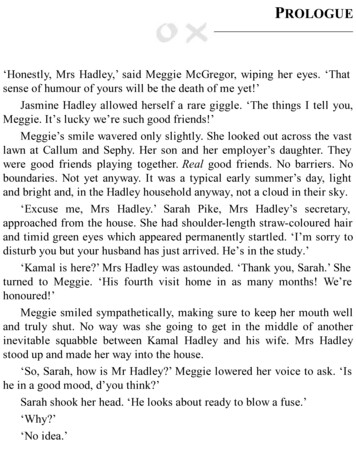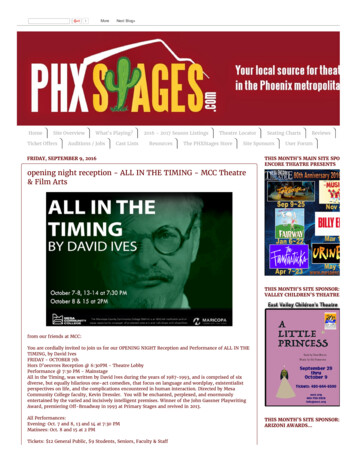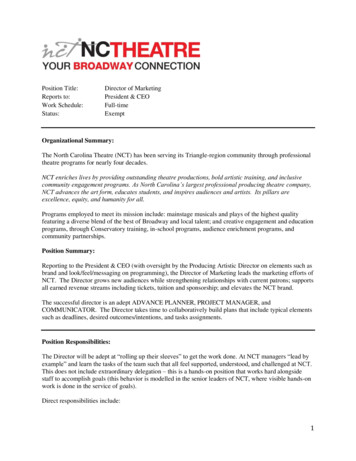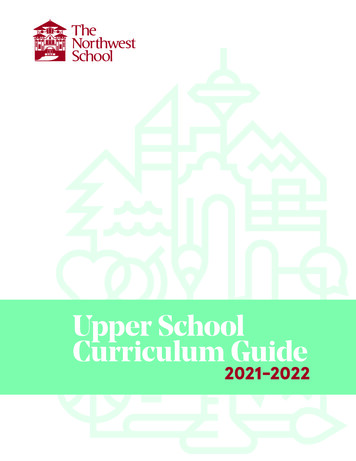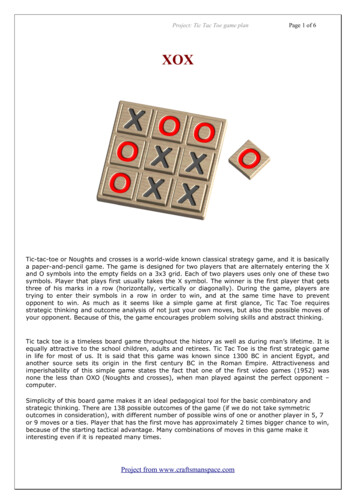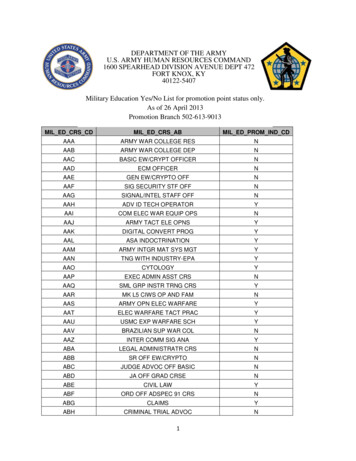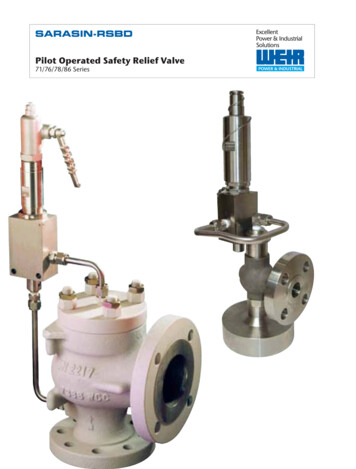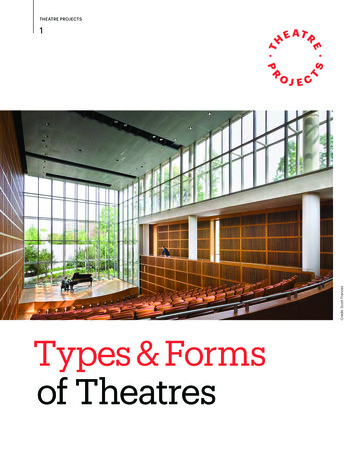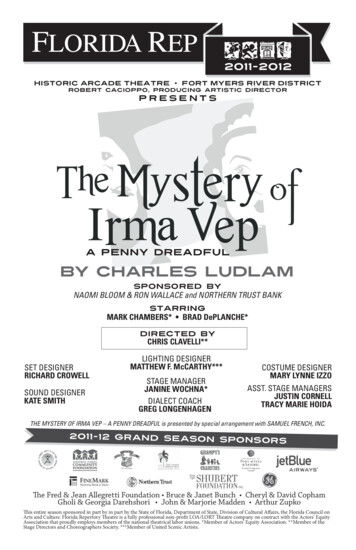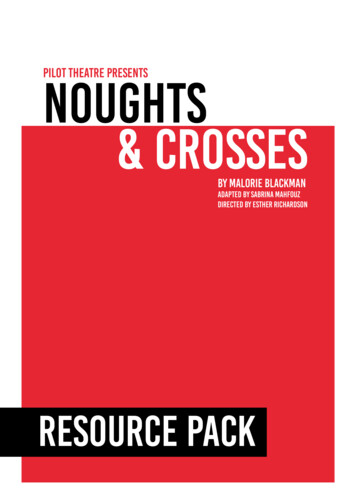
Transcription
PILOT THEATRE PRESENTSNOUGHTS& CROSSESBY MALORIE BLACKMANADAPTED BY SABRINA MAHFOUZDIRECTED BY ESTHER RICHARDSONRESOURCE PACK
CONTENTSIntroductionsynopsiscastproduction photosdesign by simon kennyvideo interviewswhy stage noughts &crosses today?pre-show workshoppost-show workshopsscene extracts (video)further resourcesparticipation programmetour dates3 -45-67-89 - 2021 - 22232425 - 3435 - 4748 - 5253-5455-5758
introductionSephy and Callum sit together on a beach. They are in love.It is forbidden.Sephy is a Cross and Callum is a Nought.Between Noughts and Crosses there are racial and social divides.A segregated society teeters on a volatile knife edge.As violence breaks out, Sephy and Callum draw closer, but this is aromance that will lead them into terrible danger.This gripping Romeo and Juliet story is a captivating drama of love,revolution and what it means to grow up in a divided world.Resource pack written by Catherine Palmer.Design by Sam Johnson.Photography by Robert Day and Sam Johnson.Filming by Ed Sunman with editing by Ed Sunman and Sam Johnson.The material in this pack may be reproduced for classroom use only and notfor resale or reproduction in print or electronically without the priorpermission of the author, film-makers or photographers.With thanks to the cast, creative, production, and admin teams and a specialthanks to the teachers and teaching professionals involved in theconsultation of the design and content of this pack. Your feedback has beeninvaluable in its development.This production will have Pilot’s trademark characteristics ofinnovative design and relevance to young people. As a text itprovokes discussion about race, equality and what it feels like to bea young person embarking on life in an adult world.The play provides a great opportunity for students studyingDrama and Performing Arts, or English at GCSE, BTEC or A level.It could be used as a comparative work when studying your set textfor English GCSE and as a cultural discussion point linking to schoolPSHE initiatives. In addition, your Drama department may use thisproduction for their live theatre question on the written paper or asdevising stimulus.Suitable for ages 12 (year 7 onwards) with tickets available forschools groups. Please check venues’ websites or box office forticket prices and offers.34
synopsisNoughts & Crosses is set in a dystopian, parallel universe in which people aredefined as Noughts and Crosses and there are significant social, economic and racialdivides.This segregated society is run by Crosses who are the dark-skinned ruling class. TheCrosses run government, have access to money, good jobs and education while theNoughts are ‘colourless’ members of the underclass. Noughts are poorer, oftenworking in service roles to Crosses with less access to education. They also have verylimited access to basic human rights and there are few laws and protocols in societyto protect them from discrimination. Segregation of the two races is activelyencouraged and enforced.Sephy is a Cross and Callum is a Nought, they grow up together as best friends andbecome completely inseparable. Callum’s mum, Meggie McGregor, works for Sephy’smum, Jasmine Hadley, as a housekeeper which allows Sephy and Callum’s friendshipto grow. When Meggie cannot lie or offer an alibi to Kamal Hadley, Sephy’s dad andHome Secretary, about Jasmine’s infidelity she is fired. This compromises Callum andSephy’s ability to be together.The segregated society they live in threatens their relationship until a newpolicy is introduced for a small number of Noughts to go to Cross schools.Callum passes the gruelling entrance exams to get a place at Heathcroft,Sephy’s school, and they imagine this will be their opportunity to be together.Callum’s time at school is difficult, protests start and segregation in school meansCallum and Sephy can’t be together. This leads to arguments between them asCallum renounces their friendship and Sephy is attacked for having lunch withCallum and the other Noughts.In this midst of their difficulties at school, Callum and Sephy’s personal lives take aturn. Lynny, Callum’s sister, is convinced she is a Cross, a repercussion of the traumaexperienced in a violent attack on her and her Cross boyfriend by Noughts. When anargument breaks out between Callum, Ryan (Callum’s dad) and Jude (Callum’sbrother) about her, she comes to the realisation she is a Nought and unable to livewith this commits suicide.Jude and Ryan’s grief from Lynny’s death pushes them to join the Liberation Militia, aterrorist group using violence to fight for the rights of Noughts. Jude reveals toCallum that they have planted a bomb in a shopping centre that Callum and Sephyplan to meet in. Callum rushes to get Sephy out moments before the explosion.5Jude is on the run and Ryan is arrested for his suspected involvement in theshopping centre bombing. A top Cross lawyer has been anonymously hired to defendhim. Callum is convinced this is Sephy’s doing and becomes more determined to dowell at school. When he returns to Heathcroft, the head teacher asks him not toattend school until the case is over. He decides to leave the school completely.During the court case, a video of Callum and Sephy running from the shoppingcentre is revealed as evidence. The jury agree on a guilty verdict and Ryan is to behung. Jasmine reveals to Sephy that she paid for the lawyer.Moments before Ryan is about to be hung, Kamal changes the sentence to life imprisonment. However, Ryan is killed soon after attempting to escape prison. Sephytells Callum she is going to boarding school. She begs Callum to run away with herand start a new life. He doesn’t reach her in time before she leaves.Callum and Sephy live apart for three years. In this time, Callum joins the LiberationMilitia reconnecting with Jude and Sephy is at boarding school. On returning home,Callum leaves a note for Sephy asking her to meet him. When they do, he (with theLiberation Militia) kidnap her.In the hideaway, the Liberation Militia put out aseries of demands including for Kamal to step down as Home Secretary. Callum isleft in charge of Sephy as the other members go to reveal the rest of their demandsin different locations.Callum and Sephy talk, he reveals he came to run away with her but she had alreadyleft. Callum tells Sephy that he loves her and they have sex. Jude returns, all theLiberation Militia members have been arrested or killed. He argues with Callumassuming he has raped Sephy and during the argument Sephy escapes from thehideaway.Sephy is pregnant. Eventually, it is leaked in the media as Callum’s baby and hecomes to visit. Again, they make plans to leave when guards surround them andCallum is arrested.Despite pressure from her family, Sephy makes a public statement to say she was notraped. Kamal visits Callum in prison and attempts to make a deal with him. He saysif Callum makes a public statement that he raped Sephy, he will get a reduced prisonsentence.Callum doesn’t agree to the deal and is hung. Sephy gives birth to their child, CallieRose McGregor, a symbol of hope for a less divided and more just world.6
The Hadley family7The mcgregor familySephy:Heather AgyepongMinerva:Kimisha LewisCallum:Billy HarrisJude:Jack CondonKamal:Chris JackJasmine:Doreene BlackstockRyan:Daniel CopelandMeggie:Lisa Howard8
PRODUCTION PHOTOS9Credit: Robert Day10
11Credit: Robert Day12
13Credit: Robert Day14
15Credit: Robert Day16
17Credit: Robert Day18
19Credit: Robert Day20
designby simon kenny“In her brilliant book Noughts & Crosses, Malorie Blackman offers us a visionof a world that looks a lot like the one we live in, but with a crucial socialdifference – it’s recognisable but strange, familiar but different. It could benow, but it’s not quite. This became key in designing the world onstage – Iwanted to create a world that we absolutely recognise and understand, butsomehow isn’t quite what we expect.While researching online, we came across some extraordinary and strangepictures created by artists working with infrared photography. Theseuncanny photos of modern cities around the world seem completely normalapart from one thing – all the greenery is captured as red. The sky is blue,the buildings are made of bricks, the bridges of metal, but the trees arered. This became our way into the world of the play – familiar, butdifferent.Rather than a series of rooms, we have a simple, abstract space andminimal furniture which we can use to represent any location we need– a canvas against which we can portray an epic sweep of drama, poetryand movement. As the story unfolds and reveals itself, so too does theset.”Simon Kenny, Designer21“a canvas againstwhich we canportray an epicsweep of drama,poetry andmovement.“Credit: Vicente Muñoz
interviewsHeather Agyepongavwhy stage noughts & crosses today?As part of our educational programme we’re working with a group ofyoung people from our consortium venues.The role of these Young Creatives is to find innovative ways to interactwith audiences beyond the production. In order to achieve this,Young Creatives have access to the workshop and rehearsal period forNoughts & Crosses and training to create a pre-show and post-showevent at their partner venue.In November, a week of pre-rehearsal workshops took place at TheatrePeckham, London. During this week, the Young Creatives worked togetherand with the Noughts & Crosses cast and Creative Team to discuss thethemes and relevance of the story for audiences today.Watch the video below to see their responses.billy harris2324
pre-show workshopsThis workshop is two hours long or parts of it can be pulled out on their ownto be explored in the classroom. If you have any questions about the contentof this workshop or how to lead certain parts of it, please contact:catherine@pilot-theatre.comTime: 2 hoursAge range: Year 7 onwardsSuitable for: This workshop is particularly apt for groups that will beattending Pilot Theatre’s production of Noughts & Crosses but could also beadapted for those who are studying the production and/or text.Subjects: Drama and Performing Arts, English, Citizenship, PSHEWarm up (10 minutes): Bottle Game (with added corruption) Split the group into two even teams and number each member of the team. Place a bottle in the middle of the two teams. Call a number out, when your number is called, those participants will runto the middle and try and grab the bottle and get back to their team. If theyare successful, they will receive a point. However, if the other person manages to tap them before they get back totheir team. They and the other team will receive the point. The first team to 10 points wins. For the first few points, play the game fairly giving points as and when ateam gets them. After this, start to add in elements that privileges one teamover the other. For example, move the bottle closer to them so it’s easier,find justifications for giving them extra points or not giving the other teama point when they get the bottle. This can start as something quite subtleand then develop further as the game continues. At the end of the game, open up a discussion with the group. Whathappened during this game? How did it make you feel? Was the game fair?This game is a practical way to highlight privilege and start discussionswith your group about this. You could apply this to many team-based gamesadapting the rules to privilege one team.25Exercises: Exploration of inequality and equalityDefining inequality and equality (5 mins):In small groups, ask them to discuss: what does inequality mean? Whatdoes equality mean? Ask each group to prepare an idea for each question tofeedback.Open up the discussion (10 mins):Ask each group to feedback their ideas and open up a discussion. You maywant to write these down if you think a visual prompt will be useful.Questions to develop the discussion might include: What can determine whether a person is treated equally? What groups of people in society now are not treated fairly? How is their experience or treatment in society different? How could society be more equal and fairer? What can we do to make thishappen?Still images (15 mins): What does inequality and equality look and feel like? In their groups, ask them to take the idea they shared with the group andcreate a still image that shows an audience what inequality looks and feelslike. You could give the suggestion that the images don’t have to be literalrepresentations of a real-life situation. They could instead focus on howsomeone may feel etc. Share these images back. Discuss with the group: What did we notice aboutthe images? How did they make us feel? Back in their groups, ask them to create another still image using the ideathey shared in the discussion that shows an audience what equality looksand feels like. Share these images back. Discuss with the group: What did we notice aboutthe images? How are the second images different to the first images? Youcould offer them prompts to think about how they are different in terms ofspace, gestures, openness etc.Scene work (20 mins) Ask the groups to use their images to create a short scene. The sceneshould start with their image of inequality and end on their image ofequality. The action of the scene should explore an experience of inequality, inwhich one or multiple characters are not treated fairly. There should thenbe an intervention which overcomes or highlights the inequality shown andbrings us to the equality image at the end. Share these scenes and discuss forms of inequality highlighted, types ofsocial action and resolutions shown.26
Staging the prologue from Noughts & Crosses (30 minutes)As a group read the prologue from Pilot’s adaptation of Noughts & Crosses:PROLOGUE – THE NURSERYA baby is crying. The ensemble enter.Grown up Sephy and Callum watch as:Meggie picks up Sephy from her cradle to console her.Two year old Callum sleeps nearby.Jasmine appears in the room– she watches Meggie for a beat.ENSEMBLE:When a newborn baby criesit means there’s lifeand with new life there’s new hope,right?MEGGIE:She’s perfect, Mrs Hadley. Persephone, such a pretty name.CALLUM:Sneaking in and out of sand dune densSEPHY:Toes tickled by the cold seaeven though we weren’t supposed to be by the waterCALLUM:Not supposed to be anywhere we couldn’t be seen,but we were UM:Laughing JASMINE:Thank you, Meggie. I’m sure her and your Callum will be great friends.BeatMEGGIE:He’ll be the luckiest boy in the world if they are, Mrs Hadley.SEPHY:Then, there was so much shouting.Meggie passes Sephy to Jasmine, deferentially but lovingly.And the scene suddenly shifts.Callum and Sephy are kids running around Jasmine and Meggie.But the two women are still and tense.Something has obviously just been said that has shocked Meggie.SEPHY:And we were friends. Best friends.CALLUM:And I was the luckiest boy in the world.CALLUM/SEPHY:I remember –27SEPHY:Leapfrogging over rocks, sleeping in treesKamal enters.Has my wife been here with you?Are you not my housekeeper? Will you not answer me?Must I roar even more, even louder?28
KAMAL:Is it true?Is it true?Has my wife been here with you?Are you not my housekeeper? Will you not answer me?Must I roar even more, even louder?SEPHY:But we knew our games had to change now.JASMINE:Meggie, just tell Mr Hadley – tell himwe were in the house with the children all last night.SEPHY:No more pretending Callum was ever going to invite me roundto his for supper.BeatCALLUM:Secret meets on Sephy’s beach as we wondered if our mums would ever speakagain.KAMAL: Meggie, you will speak.BeatMEGGIE:Mr Hadley I respect you as my boss and your wife,dare I say it, as my friend.Even so, sir,us Noughts have to find dignity where we canand I find it in truth.SEPHY:They knew we were still speaking, they couldn’t stop us, nobody could, wewere partners in crime, two of a kind.CALLUM:Biding our time til we had an excuse to be together in the open every dayagain. Til there’d be a way for a Nought kid and a Cross kid to be equals in aroom, nobody staring -KAMAL:So what is it then, your dignifying truth?SEPHY:Nobody caring -BeatCALLUM:Nobody concerning themselves with how we could be friendsMEGGIE:I I can’t give you the answer I wish I could, sir. Sorry –Meggie’s ‘sorry’ is drowned out by Jasmine’s screamsof ‘get out get out’ to Meggie as Kamal roars, the kids run away and we are leftwith Jasmine and Meggie on their own on opposite sides of the stage. Maybeteenage Callum and Sephy emerge from behind their mothers. And begin theirnew reality:CALLUM:We didn’t understand what had happened.29CALLUM:Mum was fired, so no more everyday playingin Sephy’s family grounds.SEPHY:Until one day my father made our dreams possible –CALLUM:Cross schools to let in a small number of exceptional Nought students,including – me.SEPHY:Finally, me and Callum would be together every day. I was so excited –CALLUM / SEPHY:My heart burst from my chest.30
SEPHY:Everything from now on would be perfect –BeatCALLUM:Wouldn’t it?NOTES In groups, ask them to stage the prologue in a style of their choice. Theycan use all of the text or focus on one section. They are welcome to addmusic, movement and props available to them in the room they are in. Ask them to create three rules that exist in the world of the scene.E.g. Crosses must always be higher than Noughts, therefore, if Crosses siton chairs then Noughts must sit on the floor. Or Noughts cannot make eyecontact with Crosses. Or certain words in the text provoke a certain actionor pause etc. Perform these scenes and discuss them. What stood out to you? What didyou enjoy? How could the scene be developed further?The world of Noughts & Crosses (15 mins) Drawing again on the prologue, ask the group what they learn about theworld of the play through this piece of text. You may also want to use thefirst paragraph of the synopsis to support this. Ask them to discuss what issimilar and what is different in the world of the play compared to our worldnow. In smaller groups, ask them to discuss and decide how this world wascreated. How did the Crosses take control of society? What is the history ofthe Noughts & Crosses? Did they once live together peacefully? Did something in society act as a catalyst for segregation (this could be politically,socially, economically etc). Ask them to create a sequence of three still images physicalising thishistory. You may want to add music to support this. Ask each group to perform their sequence and share what they discussedand decided about the history of the world.3132
Coming to the production (10 mins) Ask the group to look at the poster and trailer for Pilot Theatre’s productionof Noughts & Crosses. In small groups, ask them to discuss their expectations for the showbased on these materials. You may want to split groups into different elements of the production e.g. design, acting, costume, sound etc.They could discuss something they are looking forward to, something theyhope might happen in the production, something they feel confident theywill see and why. In their groups, ask young people to discuss the following question: whystage Noughts & Crosses today. Ask each group to share their ideas back in a group discussion.Reflection (5 mins) In a circle, summarise what has happened in this workshop. Go around theroom and ask each person to describe the workshop in one word or withone action.3334
pOST-show workshopSThis workshop is 1 hour and 40 minutes long or parts of it can be pulled outon their own to be explored in the classroom. If you have any questions aboutthe content of this workshop or how to lead certain parts of it, please contact:catherine@pilot-theatre.com. Please feel free to share any content producedduring this workshop with us via email or on social media. We would love tohear what your groups thought of the production.Time: 1 hour 40Age range: Year 7 onwards but with focus on providing exercises for years 10and 11. These could all be adapted for a younger age group.Suitable for: This workshop is particularly apt for groups that will be attending Pilot Theatre’s production of Noughts & Crosses but could also be adapted for those who are studying the production and/or text. Subjects: Dramaand Performing Arts, English, Citizenship, PSHE35Warm up 2: I am an expert (10 mins) In groups of 3-4, ask them to find a space in the room and a chair. Explainthat will play some music and during the music they will all dance togetherin their group. When the music stops, they should take turns to sit in the chair, once theyhave sat down, they will become an expert on the production of Noughts& Crosses. You will time 2 minutes in which they will need to tell the restof their group about the production. They must deliver it in a way thatconvinces the other members of the group they are expert on this topic. After the 2 minutes is up, repeat this again until every person in the groupshas had an opportunity to be the expert. At the end of the exercise, ask your group if they found out anything newabout the production or whether any of the experts had furthered theirthinking about an element of the production.Exercise 1: Letter writing (15 minutes) - years 7-9: In small groups, ask them to choose a character from the production towrite a letter to. You may want to offer a set of prompts and sentencestarters to drive the direction of the letters. For example:Warm up (10 minutes): Bottle Game (with added corruption)Dear , Ask your group to find a space on their own with a piece of paper and pen.Explain that for the next 5-7 minutes you would like them to write downeverything they remember from the production. This is a free writing exercise and the aim is that they keep their pen onthe page and keep writing throughout the whole period that you are timingfor. They can write down key words, bullets points, full sentences or a seriesof disconnected thoughts as long as they keep writing. This means that ifthey are struggling to think of something, encourage them to write ‘I can’tremember anything else’ or a similar statement until a new idea comes tothem rather than stop writing. At the end of the 5-7 minutes, open it up into a full group discussion askingfor points from the beginning of the production to the end. You may wantto write this on the board or on flipchart paper so they have a visual representation of the production to draw on during the workshop.We noticed .We feltbecause .We hope .In the future .Yours sincerely . Once they have finished their letters, ask each group to read them out andfeedback to one and other and what they have written.36
Exercise 2: Analysing production elements (25 minutes)Split your group into seven small groups providing them with flipchartpaper and pens. Ask each group to focus on a production element fromthe listbelow: The actor/audience relationshipGenre and styleActingSet and designMusic and sound effectsLightingCostumeGive the group 10 minutes to write about their element in the production, they should write about what they saw, heard and/or experiencedand howeffective they felt it was. They can create a spider diagram, write in bulletpoints, write key words and/or draw images to illustrate their ideas.Ask each group to share some key points from their analysis and thenstick their flipchart paper up in a part of the classroom so that eachgroup’s flip chart paper is displayed all around the space.Explain to your group that for the next 5 minutes, they should movearound the room to each of the production elements and can add to whathas already been written. They can express whether they agree with orcontest theanalysis of this element. At the end of the 5 minutes, ask a few people toshare something they have added.Give the group 10 minutes to move around the room again writing theirown notes down from the flip chart paper.Describe, explain and analyse (15 minutes)On their own, ask the group to choose one production element to focuson (this can be different to the element they focused on with their group).They must select a moment from the production that they can use as anexample of their production element and its effectiveness.37 Explain this further by examining it. You could suggest that they couldlooking at the different elements of it to explain it. Evaluate this in which they should form an opinion on how successfulthis element was, what effect it created and how it made them feel.Once they have finished writing their paragraphs, ask them to swap theirwriting with a partner. Their partner must identify where they have useddescription, explanation and analysis in their paragraph.They should also write two things they have done well and one targetto improve their work. You may want to ask for a few volunteers to readtheir paragraphs so that your students hear a range of examples.Reflection (5 minutes)In a circle, summarise what has happened in this workshop. Go aroundthe room and ask each person to share one new thing they have learnt orconsidered about the production in this workshop.Devising workshopThis workshop offers a range of warm ups and devising exercises. It doesnot follow a linear workshop plan but offers elements that you could pullout to form your own workshop plan to support your group. If you haveany questions about the content of this workshop or how to lead certainparts of it, please contact: catherine@pilot-theatre.com.The sun shines on me: Set up a circle with chairs for all of your group except one person. Thisperson will stand in the middle of the circle and say ‘the sun shines onanyone ’ and then something about themselves. If this applies to you,you get up and swap chairs and the last person who doesn’t get to sitdown will then start the next ‘the sun shines on anyone’ statement. However, in this version, you are adding a points system in so that anyof the statements that also apply to you, you give out extra points tostudents that move and offer a range of rewards to the students withthe most points. At the end of the game, ask the students to explain what happened inthe game? What did they notice about those that got extra points? Wasthe game fair?38
Step forward: identifying our own privilegesAsk your group to stand in a line. You will then share a series of statements, ask them to take a step forward for each statement that applies to them and their life experiences. At the end ofthe exercise, ask them what this shows or what they have learned aboutthe group.Example statements: You and your family always have enough money to meet your needs. You live in a decent place with a phone and television You are not teased or excluded because of your different appearanceof disability The people you live with ask your opinion on decisions that affect you You have access to extracurricular activities inside or outside of school You are not afraid of being stopped by the police You and your family go away on holiday once a year You have never felt discriminated against because of you or your parents’ origins, background, religion or culture When you are older, you can go to university or choose any job or profession you life You are not afraid of being teased or attacked in the streets, at schoolor where you live You usually see people on TV or in films who look and live as you doSource for statements: http://www.eycb.coe.int/compasito/chapter 4/pdf/4 29.pdfStatus pictureExercises that support using and understanding the text andcharacters:Movement levels into push and pull Ask the group to walk around the room with different numbers representing different levels. 0 stop, 1 slow motion, 2 Slow but very relaxed, 3 Neutral, 4 Jogging, 5 Running (sprinting). Move betweenthe different levels and instructions. You may want to add music tosupport this. Add the final instruction, when you say ‘contact’, participants pauseand make contact with another member of the group whether that istouching arms, being shoulder to shoulder or if someone is not comfortable with touch, they can make eye contact instead. Ask the group get into pairs and number themselves 1 and 2. Using their hands as a mirror and eye contact, 1 leads to push and pullnumber 2 around the room. Ask 1 and 2 to swap roles. Finally, both 1 and 2 are equal and have to work out their power relationships. They can now decide to resist or follow, or, push or pull. To develop the push and pull exercise further – you could add linesfrom the production as a stimulus to consider the power dynamics atplay between characters. In pairs, use the text on the next page. Ask your group to sit as an audience and set up a table and chair in theplaying space. Ask people to enter the image taking the most powerful, high statusposition. Keep adding people in to respond to the image being created andpausing this to ask the audience who they think in the most powerfulperson at a given moment and why. Discuss with the group: what did you notice? How did it make youfeel? What does this exercise tell you about the physicalisation ofpower?3940
Scene 7. SORRY SORRY SORRY (BEACH 2)Sephy: Why should we take the easy way out, who is it really easier for?Later at the beach, Sephy and Callum sit together, but apart.Callum: For me, obviously.Sephy: Sorry sorry sorry sorry sorry sorry sorry sorry –Sephy: You’re my friend, my oldest friend. Why shouldn’t we be friends atour school?Callum: Sephy. I
turn. Lynny, Callum’s sister, is convinced she is a Cross, a repercussion of the trauma experienced in a violent attack on her and her Cross boyfriend by Noughts. When an argument breaks out between Callum, Ryan (Callum’s dad) and Jude (Callum’s brother) about her, she comes to the realis
